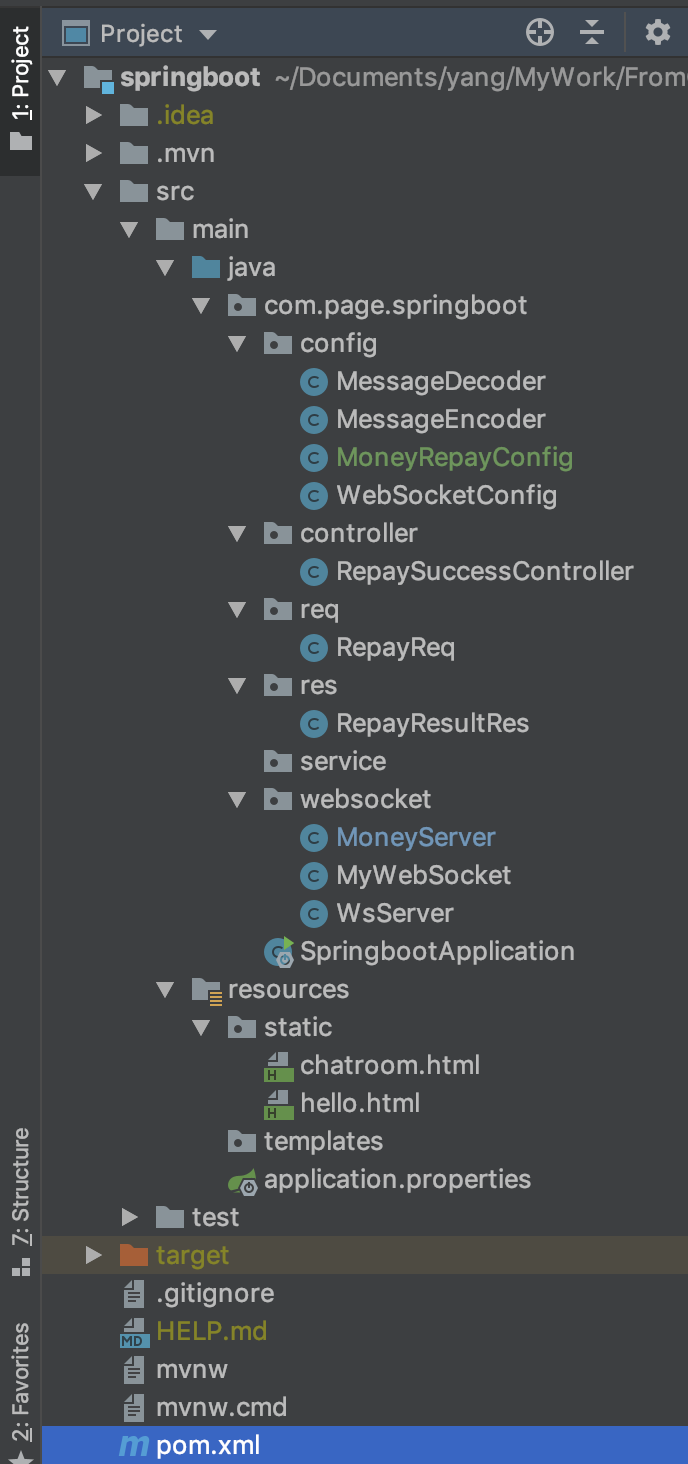1. Create a new springboot project and add a maven dependency
<dependency>
<groupId>org.springframework.boot</groupId>
<artifactId>spring-boot-starter-websocket</artifactId>
</dependency>
The file directory structure is as follows:
2. Create websocket server class
MoneyServer.java
/**
* @author Page
* @date 2019-07-02 10:00
* @description websocket service
*/
@Component
@Slf4j
@ServerEndpoint(value = "/money/{userId}", decoders = {
MessageDecoder.class,}, encoders = {MessageEncoder.class,}, configurator = MoneyRepayConfig.class)
public class MoneyServer {
private static final Map<String, Session> SESSION_MAP = new HashMap<>();
@OnOpen
public void connect(Session session, @PathParam("userId") String userId) {
// The session is stored according to the room name, and the users of each room are isolated.
SESSION_MAP.put(userId, session);
log.info("websocket Successful connection!");
}
@OnMessage
public void repay(RepayReq req, Session session) {
SESSION_MAP.put(req.getUserId(), session);
log.info("{}Paying back:{} element", req.getName(), req.getMoneyNum());
}
public void send(RepayResultRes res) throws IOException, EncodeException {
if (SESSION_MAP.get(res.getUserId()) == null) {
log.info("No connection found, message cannot be pushed");
return;
}
SESSION_MAP.get(res.getUserId()).getBasicRemote().sendObject(res);
log.info("{}Successful repayment:{} Yuan, userId:{},Repayment results:{}", res.getName(),
res.getMoneyNum(), res.getUserId(), res.isRepayResult()?"Also succeeded" :"failed");
}
}
Here I also add a custom decoder and an encoder to parse java objects and strings from the front end, as well as a custom websocket configuration class. However, nothing has been done in this configuration class at present.
MessageDecoder.java
@Slf4j
public class MessageDecoder implements Decoder.Text<RepayReq> {
@Override
public RepayReq decode(String s) {
log.info("primal string" + s);
RepayReq repayReq = null;
try {
repayReq = JSONObject.parseObject(s, RepayReq.class);
} catch (Exception ex) {
log.error(ex.getMessage());
}
return repayReq;
}
@Override
public boolean willDecode(String s) {
return (s != null);
}
@Override
public void init(EndpointConfig endpointConfig) {
// do nothing.
}
@Override
public void destroy() {
// do nothing.
}
}
MessageEncoder.java
@Slf4j
public class MessageEncoder implements Encoder.Text<RepayResultRes> {
@Override
public String encode(RepayResultRes object) {
String s = null;
try {
s = JSONObject.toJSONString(object);
log.info("primal: " + object.toString());
} catch (Exception ex) {
log.error(ex.getMessage());
}
return s;
}
@Override
public void init(EndpointConfig endpointConfig) {
// do nothing.
}
@Override
public void destroy() {
// do nothing.
}
}
MoneyRepayConfig.java
/**
* @author Page
* @date 2019-07-05 17:00
* @description
*/
@Slf4j
public class MoneyRepayConfig extends ServerEndpointConfig.Configurator{
@Override
public boolean checkOrigin(String originHeaderValue) {
log.info("1=========originHeaderValue====={}", originHeaderValue);
return true;
}
@Override
public <T> T getEndpointInstance(Class<T> clazz) throws InstantiationException {
log.info("2========{}========={}==",clazz, super.getEndpointInstance(clazz));
return super.getEndpointInstance(clazz);
}
@Override
public String getNegotiatedSubprotocol(List<String> supported, List<String> requested) {
log.info("3========{}====={}======{}", supported, requested, super.getNegotiatedSubprotocol(supported, requested));
return super.getNegotiatedSubprotocol(supported, requested);
}
@Override
public List<Extension> getNegotiatedExtensions(List<Extension> installed, List<Extension> requested) {
log.info("4======{}====={}======{}", installed, requested, super.getNegotiatedExtensions(installed, requested));
return super.getNegotiatedExtensions(installed, requested);
}
@Override
public void modifyHandshake(ServerEndpointConfig sec, HandshakeRequest request, HandshakeResponse response) {
log.info("5======{}======{}======{}", sec, request, response);
super.modifyHandshake(sec, request, response);
}
}
There are several rewritable methods in ServerEndpointConfig, through which we can get the information of websocket and modify some information of connection.
3. Create WebSocketConfig
Publish websocket service through this configuration class
@Configuration
@ServletComponentScan
public class WebSocketConfig extends WsSci {
@Bean
public ServerEndpointExporter serverEndpointExporter() {
return new ServerEndpointExporter();
}
}
4. Create controller
Here I also create a controller class to simulate the response of the server and send a message to the client.
RepaySuccessController.java
/**
* @author Page
* @Date: 2019-07-02 10:36
* @Description:
*/
@Controller
@RequestMapping("/money")
public class RepaySuccessController {
@Resource
MoneyServer moneyServer;
@PostMapping("/repaySuccess")
public void repaySuccess(RepayResultRes req) throws IOException, EncodeException {
moneyServer.send(req);
}
}
The project code has been put in my github warehouse, and can be downloaded if necessary.
Address: Welcome to visit
For more information about websocket, please refer to the official documents:
https://docs.oracle.com/javaee/7/api/javax/websocket/server/package-summary.html